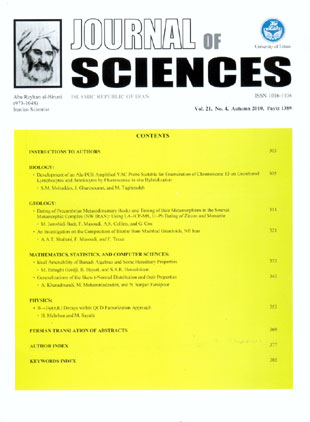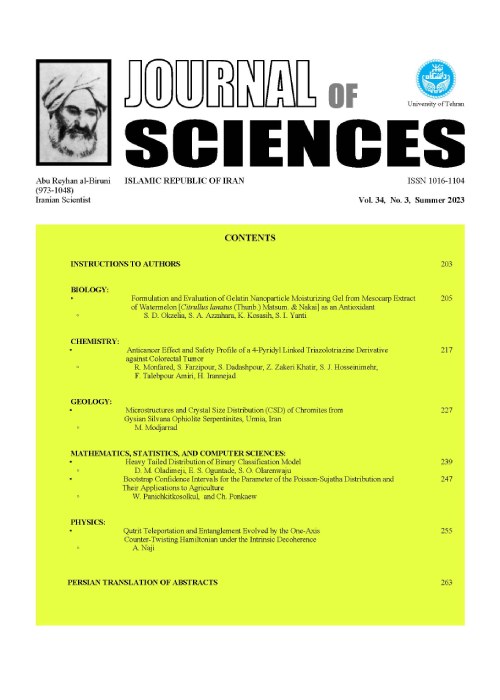فهرست مطالب

Journal of Sciences, Islamic Republic of Iran
Volume:21 Issue: 4, Autumn 2010
- تاریخ انتشار: 1389/10/01
- تعداد عناوین: 6
-
-
Page 305The main objective of the present study was to develop an efficient and reliable probe to be routinely used for detection of chromosome 13 copy numbers by interphase FISH. To achieve this, a Yeast Artificial Chromosome (YAC) containing sequences specific for human 13q12 (744D11), was cultured and the whole yeast genomic DNA was extracted. The human insert within the isolated DNA was amplified by inter-Alu PCR reaction and the PCR product was used as probe to detect the copy number of chromosome 13 using FISH experiments on 150 uncultured amniotic fluid samples after labelling with biotin or digoxigenin. Using this method 97 percent or more of the randomly evaluated cells from uncultured blood samples and 93 percent of the uncultured amniocytes showed two distinct signals on each cell. The intensity of signals was comparable to those of chromosome-specific alphoid DNA probes. The results suggest that this approach can be reliably used for prenatal detection of chromosome 13 aneuploidy.
-
Page 311Soursat Metamorphic Complex (SMC) in west of Takab city is one of the polyphase metamorphic terrenes in northern Sanandaj-Sirjan metamorphic belt of Iran. The SMC composed mainly of metasedimentary rocks associated with granitic intrusions. Based on metamorphic rocks, two metamorphic phases could be separate in the complex. M1 is representative of regional metamorphisms which varies from greenschist to amphibolite facies and consists of mica-schist, garnet-schist, staurolite-schist, kyanite- schist, fibrolite-schist, garnet amphibo lites, marble, gneiss. M2 is contact metamorphism with clear outcrop just in the central of SMC and overprinted on M1. This phase consists of andalusite-schist, cordierite-schist and Actinolite- schist. SMC is in tectonic contact with Precamb rian to Paleozoic sedimentary rocks which make it difficult to date it based on stratigraphy. In this study, U-Pb dating of zircons and Monazites used in order to find the ages of deposition and metamorphism of metasediments in SMC. U-Pb dating of zircons from a staurolite-schist in the complex by laser ablation inductively coupled plasma mass spectrometry (LA-ICP-MS) yielded a maximum Precambrian depositional age of 605±43. Monazites were also dated from a garnet-schist using the same technique and yielded a 238U/206Pb age of 61±8 which is interpreted as the age of the regional metamorphism. Based on these ages, metasedimentary protoliths of the SMC are deposited at the same time as the surrounding essentially unmetamorphosed Precambrian-Cambrian sedimentary rocks and regional metamorphism occurred later in Paleocene and could be related to the orogenesis during the collision of Arabian plate with Iranian block and closure of Neotethys.
-
Page 321Compositions of biotite from three different rock types of Mashhad granitoids, i.e., granodiorite, monzogranite and leucogranite in NE of Iran have been documented by electron microprobe and wet chemistry for Fe3+ and Fe2+. Mashhad granitoids have been geochronologically and petrologically grouped into G1 and G2 phases. Microprobe data show that the total Fe contents in biotite from G2 leucogranite are higher than those in biotite from G1 granites. In addition, the oxidation state of iron determined by wet chemistry shows that Fe3+/(Fe2+ + Fe3+) ratio in biotite from G2 leucogranite is 0.10 indicating relatively reducing whereas, in G1 ones is 0.18 and 0.23 suggesting more oxidizing conditions. The most outstanding compositional characteristics of Mashhad biotite are differences in total Al contents and Fe/(Fe+Mg) ratios. In the annite-siderophylite-phlogopite-eastonite (ASPE) quadrilateral, represented based on the above parameters, biotite samples from G1 and G2 granites define two distinct and non-overlapping trends. Each trend is characterized by a pronounced trend of increasing total Al at relatively narrow Fe/(Fe+Mg) values. The total Al contents of G1 biotite are in the range of 2.8 to 3.1, whereas, in G2, 3.3 to 3.6 (apfu). Fe/(Fe+Mg) values of G1 biotite are in the range of 0.52 to 0.59 which is considerably lower than those from G2 biotite, 0.67 to 0.72. The trend of increasing Al contents at constant Fe/(Fe+Mg) is relatively common and observed in biotite from several locations worldwide and attributed to considerable contributions from aluminous supracrustal material, either by assimilation or anatexis.
-
Page 333
Let A be a Banach algebra. A is called ideally amenable if for every closed ideal I of A, the first cohomology group of A with coefficients in I* is trivial. We investigate the closed ideals I for which H1 (A,I*)={0}, whenever A is weakly amenable or a biflat Banach algebra. Also we give some hereditary properties of ideal amenability.
-
Page 343In this paper we consider several generalizations of the skew t-normal distribution, and some of their properties. Also, we represent several theorems for constructing each generalized skew t-normal distribution. Next, we illustrate the application of the proposed distribution studying the ratio of two heavy metals, Nickel and Vanadium, associated with crude oil in Shadgan wetland in the south-west of Iran at the head of the Persian Gulf.
-
Page 353We used QCD factorization for the hadronic matrix elements to show that the existing data، in particular the branching ratios BR (? J/? K) and BR (? J/?)، can be accounted for this approach. We analyzed the decay within the framework of QCD factorization. We have complete calculation of the relevant hard-scattering kernels for twist-2 and twist-3. We calculated this decays in a special scale () and in two schemes for Wilson coefficients in NLO. We considered three functions for. The twist-3 contribution involves logarithmically divergent integral and also we considered canceling divergent. The obtained results are in agreement with available experimental data.


